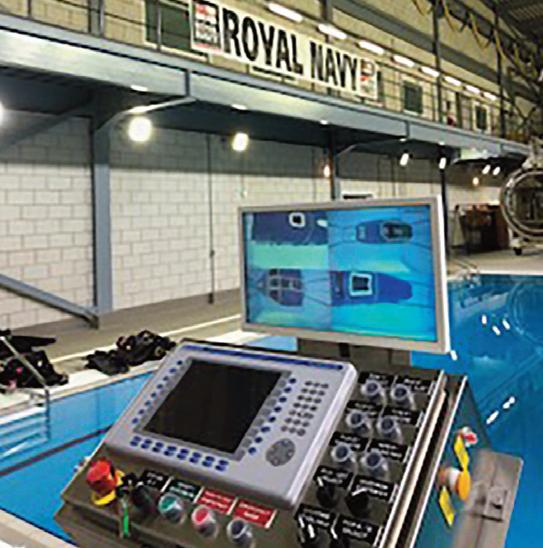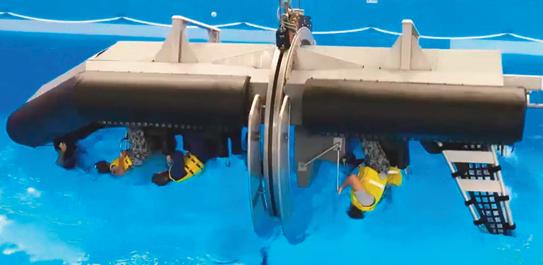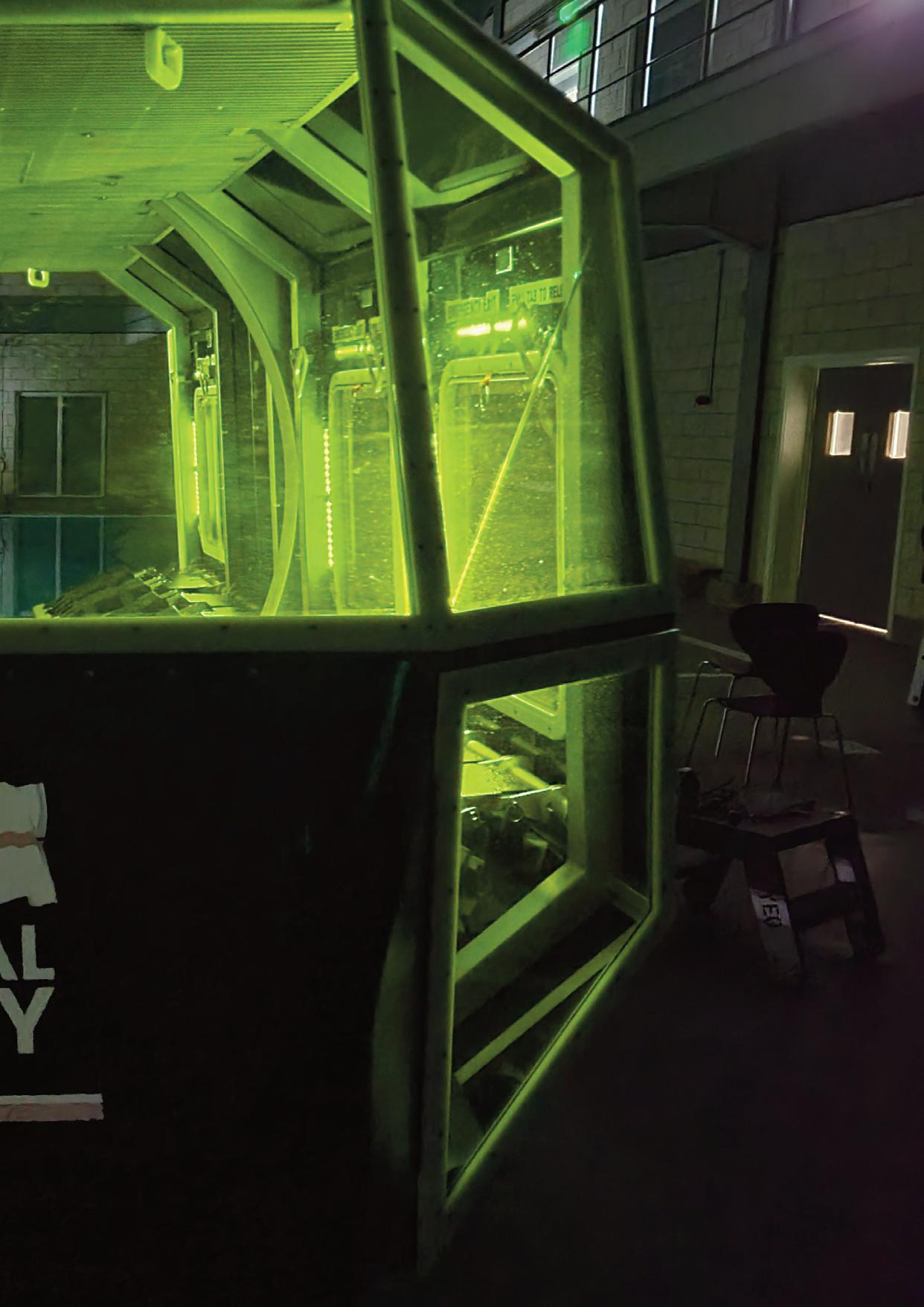
5 minute read
FIDELITY AND REALITY, AND FINANCIAL REALITY ISSUES, IN TRAINING.
and a whole set of facilities and capabilities that simulate the circumstances which may cause the incident or be the scene of the disaster.
You have to do what is required by reality not virtual or enhanced reality scenarios but real hard all singing, all dancing reality with all the nasty bits thrown in rather like malevolent sprinkles on top of a really unpleasant trick ice cream. When you are thinking “Oh Mum why did you let this happen to me?” you have to respond on your own because Mum is not there. Your training and preparation will be what takes you back to Mum.
The Canadian company Survival Systems Limited https://survivalsystemsgroup.com/ has focused on surviving malevolent events in, on or over water. Their first foray into this difficult and complex subject sprang from their founder’s personal experience in a ditched helicopter so it was only right that their initial focus was helicopters. Since that initial foundation over 40 years ago they have expanded their coverage to small boats, Rigid Hull Inflatable Boats (RHIBs), amphibious vehicles, light aircraft, single seat fast jets
From the start the basis of SSL’s training was thorough R&D based on the widest possible experience and expertise. Survivors were interviewed, forensic report studied, scientific papers examined, issues discussed and conclusions tested and re-examined. Themes emerged. First and foremost, understand your environment and what can happen within and around it. The training must reflect this. It must be realistic and replicate in as much detail as possible the reality of fighting for survival. Secondly the training must be for real, hard and demanding. Thirdly the training must inspire confidence, “The aircraft might crash but I am trained to have the best chance of survival”. Fourthly I must not fear the training, the training is to prepare me, not test me and I do not need to train to be trained. Finally, as part of the fourth item no matter how hard the training it must be safe.
SSL have involved their own team and noted academics in this work and have worked with many of the major operators of the platforms, including the US DoD, The Canadian Armed Forces and the UK MoD, who have studied the survival issues. Again, themes emerged. It is surprising how often it is the little things that make big difference. For instance, when a crash worthy seat reacts and absorbs the shock of a ditching it changes position relative to items, such as the handles for escape exits, around it. Training has to reflect this. Door mounted weapon stations must not be allowed to impede exit because they are moving freely and unpredictably. Train to deal with the issues if you are unable to design them out. If its predictable then make it occur in training. If it requires working the problem out for real than make the working out part of training. This philosophy the company adopts informs the systems it provides.
At the heart of the training systems are Modular Egress Training Simulators (METS®) and bespoke lifting systems backed by purpose designed control systems. These three components have to act in concert to provide realism and safety. They also bring other attributes; reliability, cost control and moderation, predictability, and longevity. These three core components ensure “the training for real” meets the philosophical aims and ambitions. The METS® in particular has presaged a revolution in training. Traditionally Helicopter Underwater Escape Trainers (HUET) were cast off models of real helicopters. As such if an organization has multiple helicopter types, often the same type but in differing configurations, storage space had to be found for these trainers around the pool where the training takes place. Indoor storage was required to prevent the HUET taking bird dropping and other contaminants into the pool. This requires a lot of space which starts to become expensive especially in urban areas.

Generally METS® though has three basic platforms small, medium and large and a whole host of replaceable movable panels which conform to the aircraft type. Some “specials” such as APACHE are required but the aim is to try to be modular if at all possible. These fix to the platform and by changing the panels the configuration can be changed. Swapping out a mission console to be replaced by seating can quickly transform mission training e.g. an ASW helicopter to a troop carrier variant of the same type as is the case of the Royal Navy’s ASW and Troop Carrying MERLINs. The modularity reduces price and in the event of damage, repair costs. The reduction in number reduces capital and support costs with smaller buildings etc. Lifting these around and lowering and raising them to and from the water whilst supporting them whilst they are rolled over to simulate the aircraft being underwater and upside down requires a rather special crane with different certifications from those one normally sees on building sites, for example. The system has to be predictable and consistent to allowed controlled training and extremely quick acting in an emergency. People are in the METS® and if one or more of them get into trouble upside down in the dark the response from the crane has to be instantaneous.
Training is difficult to schedule and expensive especially if the training system is unreliable and sessions have to be cancelled. Lost time in an individual or crew’s schedule and availability cannot be regained except at the additional financial cost of travel, time etc but more insidiously having to rejig personal lives to make more time available with the impact on morale and wasted personal time. Cost is not always a direct read out of a spread sheet. Recruiting replacements for crew, air crew etc hacked off by inefficient training is expensive, is a poor use of resources and does not enter into most accountants’ calculations. There is an Arab proverb “The bitterness of extra cost of poor service lingers longer than the joy of a cheap price”. It seems they had worked out whole life costing long before the spreadsheet emerged on the scene.
Having got a reliable, safe system in place for the minimum through life cost the next issue is to make the most of the capability. Here SSLs supply and thinking through the capability for training venues is important. It is fairly easy to build a pool instal a crane and provide some HUETs. It is making them work for their living and provide that fidelity in training. Boats do not usually turn over on smooth seas, waves are available(!), helicopters usually ditch when the weather is poor, fast jets frequently get into trouble, especially at sea, on take off and landing in the dark. survivalsystemsgroup.com


Providing the facility that allows the METS® to be upside down in a storm in the dark with lightning flashes and/or fog oh and rain too is a speciality of SSL’s. The SSL Survival Training Simulation Theater (STST™) does all of these. But then remember being upside down in the dark and the water is going up your nose and you are struggling to get around an obstacle that has broken loose between your seat and the emergency exit and you are asking your Mum difficult questions? The instructor may well feel you need help. All this has to be stopped instantly. STST™ does just that when commanded to do so. The crane will lift you above the water surface in 7 seconds. This combined environmental and crane safety control is part of the safety systems. Reality with safety are the watchwords.

Helicopters don’t just crash into the sea, they can crash onto the helideck of a ship or rig and the helideck safety crew have to be trained in rescue and firefighting. SSL’s Helicopter Fire Simulator (HFS™) and Modular Fire Training Facility (MFTF™) enable this to be accomplished. It is this holistic approach to training combining reality with safety that has been and will continue SSL’s success. The more one looks at it the more one realises that in the end it is real training that makes the difference when the chips are down and Mum isn’t there.










